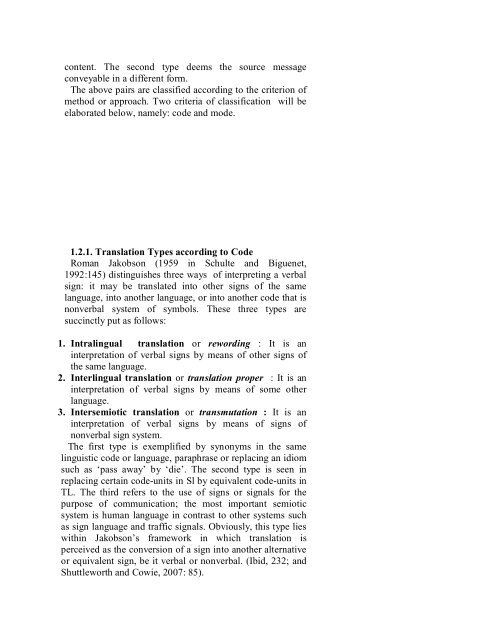424_2061_A.B.
424_2061_A.B.
424_2061_A.B.
- No tags were found...
Create successful ePaper yourself
Turn your PDF publications into a flip-book with our unique Google optimized e-Paper software.
content. The second type deems the source messageconveyable in a different form.The above pairs are classified according to the criterion ofmethod or approach. Two criteria of classification will beelaborated below, namely: code and mode.1.2.1. Translation Types according to CodeRoman Jakobson (1959 in Schulte and Biguenet,1992:145) distinguishes three ways of interpreting a verbalsign: it may be translated into other signs of the samelanguage, into another language, or into another code that isnonverbal system of symbols. These three types aresuccinctly put as follows:1. Intralingual translation or rewording : It is aninterpretation of verbal signs by means of other signs ofthe same language.2. Interlingual translation or translation proper : It is aninterpretation of verbal signs by means of some otherlanguage.3. Intersemiotic translation or transmutation : It is aninterpretation of verbal signs by means of signs ofnonverbal sign system.The first type is exemplified by synonyms in the samelinguistic code or language, paraphrase or replacing an idiomsuch as ‘pass away’ by ‘die’. The second type is seen inreplacing certain code-units in Sl by equivalent code-units inTL. The third refers to the use of signs or signals for thepurpose of communication; the most important semioticsystem is human language in contrast to other systems suchas sign language and traffic signals. Obviously, this type lieswithin Jakobson’s framework in which translation isperceived as the conversion of a sign into another alternativeor equivalent sign, be it verbal or nonverbal. (Ibid, 232; andShuttleworth and Cowie, 2007: 85).13
















